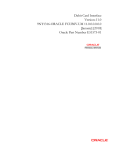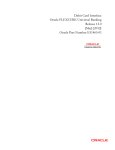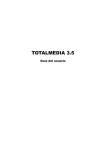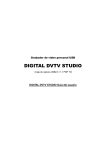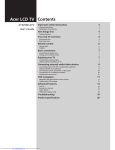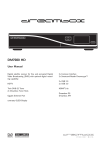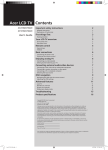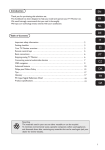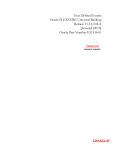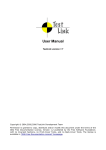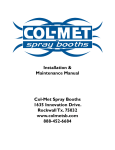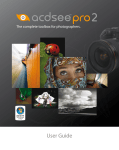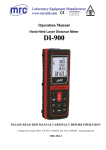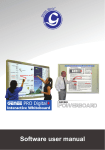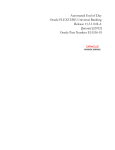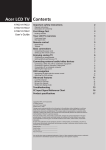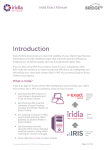Download Interface User Manual - Oracle Documentation
Transcript
Debit Card Interface Oracle FLEXCUBE Universal Banking Release 11.3.1.0.0LA [January] [2012] Oracle Part Number E51536-01 Debit Card Interface Table of Contents 1. ABOUT THIS MANUAL................................................................................................................................ 1-1 1.1 1.2 1.3 1.4 1.5 2. INTRODUCTION ......................................................................................................................................... 1-1 AUDIENCE ................................................................................................................................................. 1-1 ABBREVIATIONS ....................................................................................................................................... 1-1 CONVENTIONS USED IN THIS MANUAL ..................................................................................................... 1-1 GLOSSARY OF ICONS ................................................................................................................................. 1-1 DEBIT CARD INTERFACE .......................................................................................................................... 2-1 2.1 INTRODUCTION ......................................................................................................................................... 2-1 2.2 PROCESS FLOW ......................................................................................................................................... 2-2 2.3 MAINTAINING CARD BIN ......................................................................................................................... 2-3 2.4 MAINTAINING CARD TYPE ........................................................................................................................ 2-6 2.4.1 Maintaining Brand Details .................................................................................................................. 2-6 2.4.2 Maintaining External Services Details ................................................................................................ 2-7 2.5 MAINTAINING DEBIT CARD PRODUCTS .................................................................................................... 2-8 2.5.1 Setting Account Class Restrictions .................................................................................................... 2-10 2.5.2 Setting Preferences for Debit Card Product ...................................................................................... 2-10 2.5.3 Setting Status Movement .................................................................................................................... 2-12 2.6 MAINTAINING CARD CODE ..................................................................................................................... 2-15 2.7 MAINTAINING CARD STATUS DETAILS ................................................................................................... 2-15 2.8 MAINTAINING CARD CUSTOMER ............................................................................................................ 2-16 2.9 MAINTAINING CARD ACCOUNTS ............................................................................................................ 2-18 2.9.1 Viewing Cards Summary ................................................................................................................... 2-18 2.10 MAINTAINING CARD MASTER DETAILS .................................................................................................. 2-19 2.10.1 Specifying Additional Details ........................................................................................................ 2-24 2.11 EMBOSSING DEBIT CARD DETAILS ......................................................................................................... 2-32 2.11.1 Initiating a Status Change ............................................................................................................. 2-33 2.12 GENERATING CARD HANDOFF FILES ...................................................................................................... 2-34 2.12.1 Uploading Card Status details ...................................................................................................... 2-36 3. SCREEN GLOSSARY .................................................................................................................................... 3-1 3.1 FUNCTION ID LIST .................................................................................................................................... 3-1 1. 1.1 About this Manual Introduction This manual is designed to help acquaint you with the interface between Oracle FLEXCUBE and the other systems within your bank. This manual provides you extensive explanations about the various maintenances required for the smooth exchange of data between Oracle FLEXCUBE and the applicable systems through the interface. It also gives you an insight into the processes involved in the actual exchange of data. 1.2 Audience This manual is intended for the following User/User Roles: 1.3 1.4 Role Function Back office clerk Input functions for contracts Back office managers/officers Authorization functions Product Managers Product definition and authorization End of day operators Processing during end of day/ beginning of day Financial Controller / Product Managers Generation of reports Abbreviations Abbreviation Description System Unless and otherwise specified, it shall always refer to Oracle FLEXCUBE system EOD End Of Day CMS Card Management System BIN Bank Identification Number Conventions Used in this Manual Important information is preceded with the 1.5 symbol. Glossary of Icons This User Manual may refer to all or some of the following icons. Icons Function New 1-1 Icons Function Copy Save Delete Unlock Print Close Re-open Reverse Template Roll-over Hold Authorize Liquidate Exit Sign-off Help Add row Delete row Refer the Procedures User Manual for further details about the icons. 1-2 2. 2.1 Debit Card Interface Introduction Oracle FLEXCUBE facilitates the processing of debit card transactions originating from Automatic Teller Machines (ATM) and POS terminals attached to different branches of your bank. You will be allowed to capture different types of debit cards in Oracle FLEXCUBE. The cards are linked to individual customer accounts. You need to do the following maintenance in Oracle FLEXCUBE for the debit card interface to work: Card BIN Maintenance: Card BIN maintenance should be created for every issuer product that the bank wishes to provide to customers. These BINs would be provided to bank typically by networks like VISA/MasterCard or by ISO organization. ATM and POS transaction count and amount limits are maintained for every BIN in this maintenance Card Type Maintenance: Card Types should be created to uniquely identify the set of Issuer BINs maintained. For example Visa might issue 433333 and 422222 under ‘Classic’ type and 455555 and 466666 under ‘Gold type’ etc. Card Product Maintenance: Card product maintenance is to link a given card type to a card product. You are not able to link multiple card types to same card products. Card products are linked in Debit Card Product Maintenance to uniquely identify the card nature that is requested. Card Status Maintenance: Card status has to be defined as card applied, closed, card issued, activated, and blocked. Card Customers Maintenance: Card customer should be maintained. Card Accounts Maintenance: This maintenance is required for creating the customer account who wishes to avail the card. Card Requests Maintenance: This is the master table which stores the card request and further life cycle details. 2-1 2.2 Process Flow The following flow diagram depicts the working of the Debit Card Interface: start Define Card Bins with Limits Define Card Customers Define Card Types Define Card Status Define Card Accounts Define Card Products Create Debit Card Request Maintenance Card Bin ,Type, Product, Limits, Customer, Account, Status Card Status Query Card Production Handoff File Card Status Update 2-2 2.3 Maintaining Card BIN You have to create Card BIN maintenance for every issuer product that the bank wishes to provide to customers. You can maintain the details of the card BIN in the 'Card BIN Maintenance' screen. You can invoke the 'Card BIN Maintenance' screen by typing 'STDBINMT' in the field at the top right corner of the Application tool bar and clicking the adjoining arrow button. Specify the following details in this screen: Card BIN Specify the Bank Identification Number (BIN). Description Specify the description of the BIN. Bank Institution Id Specify the bank institution code. Default Renewal Unit Select the default renewal unit of the cards issued under the card BIN from the drop-down list. This list displays the following values: Year Month Week Day Default Renewal Cycle Specify the default renewal unit value of the cards issued under the card BIN. You cannot use zero or a negative value as the default renewal cycle. 2-3 Example To indicate that the card should be renewed after every 2 Years when the Default Renewal Unit is Yearly, you have to specify the Default Renewal Cycle as 2. ATM Limit Specify the following details pertaining to ATM limit: ATM Limit Unit Select the unit of ATM Limit count for transactions control from the drop-down list. This list displays the following values: Year Month Week Day ATM Count Limit Specify the number of ATM transactions allowed for the unit defined for ATM. ATM Amount Limit Specify the maximum permissible amount for the unit defined for ATM. Example Specify 1000 to indicate 1000 account currency per unit. Remote ATM Limit Unit Select the unit of ATM Limit count for transactions control, for transactions done from ATMs outside the bank network, from the adjoining drop-down list. This list displays the following values: Year Month Week Day Remote transaction means transactions done outside the bank network. For example, an ATM transaction done in ICICI ATM using CITIBANK debit card. Remote ATM Count Limit Specify the number of ATM transactions allowed for the unit defined for remote ATM. Remote ATM Amount Limit Specify maximum permissible amount for the unit defined for remote ATM. Example Specify 1000 to indicate 1000 account currency per unit. POS Limit Specify the following details pertaining to POS limit: 2-4 POS Limit Unit Select the unit of POS Limit count for transactions control from the drop-down list. This list displays the following values: Year Month Week Day POS Count Limit Specify the number of POS transactions allowed for the unit defined for POS. POS Amount Limit Specify the maximum permissible amount for the unit defined for POS. Example Specify 1000 to indicate 1000 account currency per unit. Remote POS Limit Unit Select the unit of POS Limit count for transactions control from the drop-down list. This list displays the following values: Year Month Week Day Remote POS Count Limit Specify the number of transactions allowed from a remote POS. Remote POS Amount Limit Specify maximum permissible amount for the unit defined for remote POS. Example Specify 1000 to indicate 1000 account currency per unit. 2-5 2.4 Maintaining Card Type You can maintain the card type in the 'Card Type Maintenance' screen. You can invoke the 'Card Type Maintenance' screen by typing 'STDTYMNT' in the field at the top right corner of the Application tool bar and clicking the adjoining arrow button. Specify the following details in this screen: Card Type Specify the type of the card. Description Specify the description of the Card type. BIN Details Specify the BIN details here: Brand Specify the brand name of the card. Card BIN Select the BIN for the card issued from the option list. You can associate multiple BINs to the same card type. 2.4.1 Maintaining Brand Details A brand represents the bank from which the debit card is issued. You can maintain card issuing banks in the ‘Brand Maintenance’ screen. You can invoke this screen by typing ‘STDDCBRD’ in the field at the top right corner of the Application tool bar and clicking the adjoining arrow button. 2-6 In this screen you can maintain the following details: Brand Name You can capture the name of the brand or the bank issuing the debit card. Description You can state a brief description of the brand in this field. Whenever you select a brand in any other function, its corresponding description will be displayed automatically alongside. 2.4.2 Maintaining External Services Details You can also maintain details of an external service that represents the channels where the debit card can be used. Oracle FLEXCUBE allows you to do so through the ‘External Service Maintenance’ screen. You can invoke this screen by typing ‘STDEXTSY’ in the field at the top right corner of the Application tool bar and clicking the adjoining arrow button. 2-7 In this screen you can maintain the following details: External Service You can capture the external service name in this field. Description Here you can capture a brief description of the external service so that whenever the external service name is specified, its corresponding description is automatically displayed alongside. 2.5 Maintaining Debit Card Products You can maintain debit card product in the 'Debit Card Product Maintenance' screen. This screen links a given card type to a card product (one to one). You are not allowed to link multiple card types to same card products. Card products are linked to uniquely identify the card nature that is requested. You can invoke the 'Debit Card Product Maintenance' screen by typing 'STDCPROD' in the field at the top right corner of the Application tool bar and clicking the adjoining arrow button. 2-8 Specify the following details in this screen: Card Product Specify the Product Code. Description Specify the description of the specified Card product. Card Type Specify the type of Card allowed for the card product. Expiry Date Specify the date after which the card product cannot be used. Debit/Credit Card Select the type of the card. GL Account Specify the GL account for the card from the adjoining option list. The option list displays all the GL accounts maintained in the system. Choose the appropriate one. Offset Account Specify the offset account for the card from the adjoining option list. The option list displays all the offset accounts maintained in the system. Choose the appropriate one. 2-9 Transaction Code Specify the transaction code for the card from the adjoining option list. The option list displays all the transaction codes maintained in the system. Choose the appropriate one. Other Transaction Code Specify the other transaction code for the card from the adjoining option list. The option list displays all the transaction codes maintained in the system. Choose the appropriate one. 2.5.1 Setting Account Class Restrictions You can set the account class restrictions applicable to a debit card product using ‘Account Class Restrictions’ screen. To invoke this screen, click ‘Account Class Restrictions’ button from the ‘Debit Card Product Maintenance’ screen. Account Class Specify the account class to be attached with the card product to indicate the eligibility of issuing the card poduct. Primary Card Yes/No Check this box to indicate whether this account class is applicable for issuing the primary debit card. Secondary Card Yes/No Check this box to indicate whether this account class is applicable for issuing the secondary debit card. 2.5.2 Setting Preferences for Debit Card Product You can set the preferences applicable to a debit card product using ‘Preferences’ screen. To invoke the screen, click ‘Preferences’ button from the ‘Debit Card Product Maintenance’ screen. 2-10 Specify the following details: Type Number You can capture the card type number which is used to arrive at the card number. This is an optional field. Auto Renewal of Cards System defaults the value of this check box based on the ‘Bank Parameters Maintenance’ screen. However you can modify this and decide and choose whether or not to renew the card automatically. Invalid PIN Login Limit Specify the maximum number of invalid PIN login allowed for the card. If the number of wrong tries on the card reaches this limit, the system automatically block the card. However, this will be a temporary block and the system unlocks the card at the end of day. However, if any debit card transaction is received with correct PIN, before Invalid PIN Count becomes equal to Invalid PIN login Limit, then the system will reset the Invalid PIN Count to zero. Validate Terminal ID Check this box to indicate whether the debit card requires terminal id validation during transaction or not. If you check this option, during any card transaction, the system will validate the terminal ID coming from the external system against the terminal ID maintained at the card level. Validity Period Specify the validity period of the card in months. When a card is renewed or created, the system always calculates the expiry date of the debit card on the basis of the parameters maintained in the debit card type maintenance. The expiry date is arrived by considering the month end date of the expiring month and year. 2-11 For example, assume that a card is created on November 25, 2009 and will expire after five years. The card will be valid till November 2014 and the expiry date will be November 30, 2014. Card Type Indicate the type of card maintained. You can select one of the following options: Regular Card Dummy Card Intended Customer Choose the type of customer from the following options: All Individual Corporate Card Renewal Period Specify the card renewal period, in terms of months. If you specify ‘2’ as the card renewal period, the system will renew the card two months before its expiry date. Renewal Status Specify the status of card renewal. Number of Cards Number of Primary Cards Specify the number of primary cards allowed for the customer. Number of Add-on Cards Specify the number of add-on cards allowed for the customer. 2.5.3 Setting Status Movement You can set the status movement applicable to a debit card product using ‘Status Movement’ screen. To invoke this screen, click ‘Status Movement’ button from the ‘Debit Card Product Maintenance’ screen. 2-12 Card Product System displays the card product name from the main screen. Status Select the debit card status from the adjoining option list. The list shows all the status codes maintained in the Status Codes Maintenance screen. Next Status Specify the next status to which the card can move. The option list shows all the status codes maintained in the Status Codes Maintenance screen. Movement Mode Select the status movement mode from the specific status to the next status. This can have the following values: Manual: Indicates the status change from the current status to the next status can be done manually. This is the default value which you can change. Automatic: Indicates the status change from the current status to the next status is automatic. Movement Days Specify the number of days for which a card will have the current status for being eligible for the automatic status movement. This field will be disabled if the status ‘Movement Mode’ is manual. Action Specify the debit card operation which will change the card status from the current status to the next status. This can have the following values: Approve Reject 2-13 Cancel Block Activate Destroy Renew with cancellation Renew with cancellation on activation Renew Deactivate Renew Check this box to specify whether the card needs to be renewed or not. If you check this box, a new card will be issued for this status change. Renewal Status Specify the status of the new card. This field will be enabled only if the check box ‘Renew’ has been checked. For a specific status, the system ensures that the value of movement days is unique for the all next statuses which have Movement Mode as automatic. This further ensures that for a specific status, based on the number of days that the card has been lying in the status, there is only one destination status for automatic movement. Example The status maintenance for a debit card can be done as per the following table Status Previous Status Mode of Movement Movement Days Action Rejected Requested Manual Reject Under Creation Requested Manual Approve Inactive Under Creation Manual Dispatch Blocked Inactive Automatic Active Inactive Manual Cancelled Blocked Automatic Cancelled Active Manual Cancel Destroyed Cancelled Manual Destroy Active Active Manual Renew with Cancellation on Activation Cancel Active Manual Renew with Cancellation Requested X Activate Y 2-14 2.6 Maintaining Card Code You can maintain card code details using ‘Card Code Maintenance’ screen. You can invoke this screen by typing ‘STDDCMNT’ in the field at the top right corner of the Application tool bar and clicking the adjoining arrow button. You can spedify the following details: Card Code Specify the debit card code. The adjoining option list displays all the valid card codes maintained in the ‘Debit Card Limit Maintenance’ screen. You can select the appropriate one. The values present in the option list are derived from the user defined maintenance. Description You can specify the debit card code description here. 2.7 Maintaining Card Status Details You can maintain the card status in line with the Card Management System in the 'Card Status' screen. You can invoke the 'Card Status' screen by typing 'STDSTATM' in the field at the top right corner of the Application tool bar and clicking the adjoining arrow button. 2-15 Specify the following details in this screen: Card Status Specify the status of the card. Initially, when the request for the card is initiated, the card status will be ‘Card applied’. Later you can change this to any status depending upon the need. The card status can be of the following: R – Specify 'R' to indicate the status as Requested A- Specify 'A' to indicate the status as Activated C- Specify 'C' to indicate the status as Closed Card Issued when the card is sent with PIN and physical card B - Specify 'B' to indicate the status as Blocked Theese codes are factory-shipped codes and can be modified at the time of implementation based on the Card Management System used by your bank. Description Specify a description for the status. 2.8 Maintaining Card Customer You can maintain the card customer in the 'Card Customer Maintenance' screen. You can invoke the 'Card Customer Maintenance'screen by typing ' STDCUSTM' in the field at the top right corner of the Application tool bar and clicking the adjoining arrow button. 2-16 Specify the following details in this screen: Branch Code The branch code gets defaulted here. Customer ID Select the customer ID from the adjoining option list. The option list displays all the customers maintained in the system. Customer Name The customer name gets displayed, on selecting the customer id. However, you are allowed to change the customer name. Based on this the customer name will appear in the card master screen. If Card Management System needs extra fields, the same can be maintained as UDFs using this screen. Click the ‘UDF’ button to maintain User Defined Fields for the CMS. System validates the following: if any card customer is open at customer closure level – if any card customer is open that card customer needs to be closed before customer closure. if any card customer is closed during customer reopen – if the customer is closed, system will not allow the card customer to be reopened. 2-17 2.9 Maintaining Card Accounts You can maintain the customer accounts which can be linked to cards in the 'Card Accounts Detail' screen. Also you can view the various cards attached to the same account using this screen. You can invoke the 'Card Accounts Detail' screen by typing 'STDCARDA' in the field at the top right corner of the Application tool bar and clicking the adjoining arrow button. Specify the following details in this screen: Branch Code Specify the branch code. Customer ID Select the Customer ID from the option list. Customer Account Number Select the customer account number from the option list. 2.9.1 Viewing Cards Summary In query mode, you can click 'Cards' button to see the summary of the cards related to the account. 2-18 If Card Management System needs extra fields, the same can be maintained as UDFs using the ‘Fields’ screen. Click ‘Fields’ Button to invoke the ‘Fields’ screen. System validates the following: if any card customer is open at customer closure level – if any card customer is open that card customer needs to be closed before customer closure. if any card customer is closed during customer reopen – if the customer is closed, system will not allow the card customer to be reopened. 2.10 Maintaining Card Master Details The life-cycle of the card is maintained using the 'Card Master Maintenance' screen, right from raising card request to the card expiry/renewal. You can invoke the 'Card Master Maintenance' screen by typing 'STDCRDMS' in the field at the top right corner of the Application tool bar and clicking the adjoining arrow button. This is the master table which stores the card request and further life cycle details. This screen is used for the following: To create new card requests To amend the card status manually( or through online upload ) To query the Card to accounts / Account to Cards linkages by Oracle FLEXCUBE To generate the handoff file ( new card requests ) To generate the renewal file 2-19 Specify the following details: Branch Code Branch code gets defaulted to current branch. Card Product Specify the product code of the card. Request Reference Number This is a system generated number.This reference number is used while doing updates based on response from CMS. Customer No Specify the customer number in case of request/renewal. Account No Specify the Customer Account Number. It is validated against the customer account marked with ‘ATM Facility’. Card BIN Select the Card BIN from the option list. 2-20 Customer As part of specifying the details pertaining to customer, you can specify the following: Name on Card Customer name gets displayed as maintained in ‘Card Customer Maintenance’ screen. However, you are allowed to modify it. Owner ID Type Specify the type of ID produced. For example, PAN, Passport, DL etc. Owner ID Number Specify the identification number of the applicant. Additional Holder ID Type Specify the type of ID produced by additional holder. For example, PAN, Passport, DL etc. Additional Holder ID Number Specify the Identification Number of the additional holder. Recovery Account Specify the recovery account here. Additional Holder Date of Birth Specify the date of birth of the additional holder from the adjoining calendar. Additional Holder Relation Specify the relation of the additional holder with the card holder. Card As part of specifying the card details, you can specify the following: Primary Card No In case of Secondary Cards, system displays the Primary Card Number here. Card Number It is generated by CMS when the mode is Request/renewal. However, you are allowed to specify the card number. Card Sequence Number Card Sequence Number is generated and displayed by the system. It is the running number 1.2.3…. 2-21 Primary Card By default, system considers the first Debit Card issued for an account as the primary card and hence checks this box. You are not allowed to change the same. System unchecks this box on subsequent card issued for the same customer account. Card Application Date Specify the date of card application. Card Issued Date Specify the date of issue of the card. Card Renewal Date The date of renewal of the card gets defaulted from the BIN level. Card Expiry Date Specify the expiry date of the card. Card Activation Date Specify the date of activation of the card. Issuer Specify the name of the issuer. Plastic Type Specify the card type here. Credit Card Limit Specify the credit limit for the customer. Status As part of the specifying the satus, you can specify the following: Card Dispatch Status Select the Dispatch Status from the drop-down list to indicate whether the card has been dispatched or not. Pin Mailed Status Select the PIN Mailed Status from the drop-down list to indicate whether PIN has been mailed to the cardholder or not. Card Status Specify the status of the card e.g. Active/Blocked etc. Last Status Change Date Specify the date of last status change. 2-22 Last Operation Specify the last operation done on card. Delivery Channel for Card Specify the delivery channel for the card dispatch. Delivery Channel for PIN Specify the delivery channel for the PIN. Delivery channel for Card and PIN should be different. Renewal As part of the details pertaining to renewal, you can specify the following: Remarks Specify comments, if any. Renewal Unit Renewal unit gets defaulted here. Renewal Cycle Renewal cycle gets defaulted here. Bill Cycle ATM The following details are displayed: ATM Limit Unit ATM Limit Unit gets defaulted from BIN. ATM Count Limit ATM Count Unit gets defaulted from BIN. AMT Amount Limit AMT Amount Unit gets defaulted from BIN. Remote ATM Limit Unit Remote transactions allowed through ATM unit gets defaulted. Remote ATM Count Limit Remote transactions unit allowed through ATM gets defaulted. 2-23 Remote ATM Amount Limit Remote transactions allowed amount through ATM gets defaulted. POS The following details are displayed: POS Limit Unit POS Limit Unit gets defaulted from BIN POS Count Limit POS Count Unit gets defaulted from BIN POS Amount Limit POS Amount Unit gets defaulted from BIN Remote POS Limit Unit Remote transactions allowed through POS unit gets defaulted. Remote POS Count Limit Remote transactions unit allowed through POS gets defaulted. Remote POS Amount Limit Remote transactions allowed amount through POS gets defaulted. 2.10.1 Specifying Additional Details You can capture the additional details pertaining to the debit card using ‘Additional Details’ screen. To invoke the screen, click ‘Additional Details’ button on the ‘Card Master Maintenance’ screen. 2-24 Specify the following details: Debit Card Details Brand Specify the brand of the card. The option list displays all brands applicable. Choose the appropriate one. Alternate Customer Number The system displays the alternate customer number. The debit card will be linked to the account of this customer. Additional Account Number Specify the additional account number for the customer. Additional CIF Number Similar to assigning identification numbers for the primary cardholders, you can have numbers to identify the secondary cardholders as well. This will be applicable only if the add-on/secondary cardholder is a Oracle FLEXCUBE customer. 2-25 External Service Select the external service name. The adjoining option list displays all the valid external services maintained in the system. You can select the appropriate one. FC Customer Check this box to indicate that the additional card holder is an FC customer. Status Change Date This field will capture the date of the last status change for the debit card. Whenever the status of the card is changed manually or by the debit card batch, the system will update this field value with the system date. Other Details Card Creation Type Select the card creation type from the drop-down list. You have the following options: Normal Express mode Status Since Date At any given point of time, the screen will display the latest status of the card. The date entered in this field will indicate the period/day when the card moved into the current status. Member Since Here, you have to specify the date since when the customer has become a cardholder. Status Reason Enter a valid reason for the status of the card. First Transaction Date Specify the date on which the first transaction occurred using the debit card. Last Transaction Date Specify the date on which the last transaction occurred using the debit card. UID Type Specify the unique ID of the debit card. UID Value Specify the value of the unique ID. Terminal Identification Specify the identification number of the terminal at which the card is used. 2-26 Delivery Instructions Print Status Check this box to indicate whether the card is already printed or not. Printing Required Check this box to indicate whether this card is to be printed online or not. Dispatch Value Specify the dispatch value. It will contain the branch code, if the ‘Dispatch By’ selected is ‘Branch’ else it will contain a courier value used by the bank. Card Code Specify the debit card code. The adjoining option list displays all the valid card codes maintained in the ‘Debit Card Limit Maintenance’ screen. You can select the appropriate one. The values present in the option list are derived from the user defined maintenance. Secondary Account Details Branch Specify the branch where the secondary account of the debit card is maintained. Account Number Specify the account number of the secondary account that the debit card is linked to. Delink Check this box to indicate that the secondary account is linked to the card 2.10.1.1 Specifying Personal Details To specify the personal details, click on the ‘Personal’ tab in the ‘Additional Details’ screen’. 2-27 You can specify the following details here: Holder Name Specify the name of the debit card holder. Address Specify the address of the debit card holder. City Specify the name of the city. Municipality Code Specify the municipality code of the city. Post Code Specify the post code of the city. PO Box 2-28 Specify the PO box number. Telephone Number Specify the telephone number of the debit card holder. Fax Number Specify the fax number of the debit card holder. Telext Number Specify the telext number of the debit card holder. PIN Specify the PIN of the city. PIN Change Date System displays the last PIN change date here. 2.10.1.2 Specifying Limit Details To specify the limit details, click on the ‘Limits’ tab in the additional details screen. 2-29 System displays the following details: Internal Limit Utilized ATM Count Utilized System displays the internal count for the total number of transactions made in ATM ATM Amount Utilized System displays the internal count for the total number of amount withdrawn from ATM. POS Count Utilized System displays the internal count for the total number of transactions made in POS. POS Amount Utilized System displays the internal count for the total number of amount withdrawn from POS. Remote Limits Utilized ATM Count Utilized System displays the remote count for the total number of transactions made in ATM ATM Amount Utilized System displays the remote count for the total number of amount withdrawn from ATM. POS Count Utilized System displays the remote count for the total number of transactions made in POS. POS Amount Utilized System displays the remote count for the total number of amount withdrawn from POS. Transaction Date Details First Transaction Date in ATM System displays the first transaction carried out in ATM except the PIN change. The field will not be updated for the further ATM transactions. Last Transaction Date in ATM System displays the date of the last transaction carried out in ATM. The field will update the dates of the further transactions. First Transaction Date in POS System displays the date of the first transaction carried out in POS. The field will not be updated for the further POS transactions. 2-30 Last Transaction Date in POS System displays the date of the last transaction carried out in POS. The field will update the dates of the further transactions. 2-31 2.11 Embossing Debit Card Details You can generate debit card details using ‘Debit Card File Embossing’ screen. To invoke this screen, type ‘STDDEMBS’ in the field at the top right corner of the Application tool bar and click the adjoining arrow button. Specify the following details: File Reference Number The system displays the file reference number. File Type The system displays the file type as ‘Adhoc’ or ‘Regular’. File Generated If this box is checked, it implies that the ASCII file has been generated for embossing. Debit Card Details Card Issue Reference Specify the card issue reference. The adjoining option list displays a list of reference numbers maintained in the system. Choose the appropriate one. Debit Card Number Specify the debit card number. The adjoining option list displays a list of all file formats maintained in the system. Choose the appropriate one. Account Number Specify the account number. 2-32 Click ‘Generate File’ button to generate the details of the debit card. 2.11.1 Initiating a Status Change Oracle FLEXCUBE allows you to manually change the status for a single debit card or a group of cards lying in the same status, through the ‘Debit Card Status Change’ screen. You can invoke this screen by typing ‘STDCSTCH’ in the field at the top right corner of the Application tool bar and clicking the adjoining arrow button. This screen has the following fields: Card Status The status of the card for which you want to initiate a status change is displayed in this field. Card Number System displays the debit card number in this field however; you can select the card number from the adjoining option list. Card Status System displays the current status of the card. Status Change Check this box to indicate whether the status of the specific card have to be changed or not during bulk status change. New Status The new status allowed for the specific card status is displayed in this field. The value gets defaulted from the corresponding values maintained in the ‘Debit Card Status Movement’ screen. Reason Code Specify the reason code for the status change from the adjoining option list. 2-33 Click ‘Status Change’ button to change a status for the chosen debit card. You can query for cards lying in a specific status by selecting the status and clicking on the ‘Fetch’ button. Similarly, you can also query for a specific card. After querying, you can opt to change the card status by checking the ‘Status Change’ option. You can choose the status change action from the option list. The system will change the status of the selected cards to the new status. The status change log will also be updated with the details. 2.12 Generating Card Handoff Files You can generate handoff files in Card Info handoff file format using the 'Card Handoff Batch' screen. You can invoke the 'Card Handoff Batch' screen by typing 'DCDBATCH' in the field at the top right corner of the Application tool bar and clicking the adjoining arrow button. This batch can be configured as either ad-hoc run or EOD run. It generates the 'Oracle FLEXCUBE Specific CMS Handoff Format'. Click ‘Run’ button in this screen to run the handoff batch. This helps you to generate the ASCII files online for the debit cards. 2-34 File Format The format of the handoff file genrated is broadly structured as given below: Request 1 <Customer record >CRLF <Account record>CRLF <Card record>CRLF Request 2 Seq# <Customer record>CRLF <Account record>CRL <Card record>CRLF Field Name Size Remarks Customer Record (Source STTM_CUSTOMER) 1 Bank code 10 DCTM_CARD_ISS_BIN..BANK_INST_ID 2 Branch code 3 Customer local branch 3 customer code 9 4 customer type 1 5 Last name FC size 6 First name FC size 7 Short name FC size 8 Sex 1 0 - male, 1-female, 9 Married 1 0 -single, 1 - married, 2 - divorced, 3seperatd 10 Address 1 FC size 11 Address 2 FC size 12 Address 3 FC size 13 Address 4 FC size 14 City FC size 15 Pin Code FC size 16 work Phone FC size 17 Home Telephone FC size 0 - bank, 1 -individual, 2 - corporate Account Record(Source STTM_CUST_ACCOUNT) 2-35 Seq# Field Name Size Remarks 1 Bank code 10 DCTM_CARD_ISS_BIN..BANK_INST_ID 2 Branch code FC size Account branch 3 Customer code FC size 4 Account number FC size 5 Account currency FC size 6 Account currency numeric FC size 7 Account type 2 10 -current, 20- savings Card Record(Source DCTM_CARD_MASTER) 1 bank code 10 2 FC_reference_no 3 Branch code FC size 4 customer code FC size 5 Account number FC size 6 Card Product code 4 DCTM_CARD_MASTER.CARD_PRODUC T 7 Primary/secondary card 1 0 - primary, 1 - secondary 8 Card status 1 1 - request 9 PAN This need to be used by CMS when sending card status change Not used You can define the required format for the handoff file through the Generic Interface module, in case a different format is required. 2.12.1 Uploading Card Status details You can upload the new card details into Card Master Maintenance through Incoming Generic Interface module. Similarly, you can upload card status details or any amendments through Generic Interface module. 2-36 3. Screen Glossary 3.1 Function ID List The following table lists the function id and the function description of the screens covered as part of this User Manual. Function ID Function Description DCDBATCH Card Handoff Batch STDBINMT Card BIN Maintenance STDCARDA Card Accounts Detail STDCPROD Debit Card Product Maintenance STDCRDMS Card Master Maintenance STDCUSTM Card Customer Maintenance STDSTATM Card Status STDTYMNT Card Type Maintenance STDDCBRD Brand Maintenance STDEXTSY External Service Maintenance STDDEMBS Debit Card File Embossing STDCSTCH Debit Card Status Change 3-1 Debit Card Interface [January] [2012] Version 11.3.1.0.0LA Oracle Corporation World Headquarters 500 Oracle Parkway Redwood Shores, CA 94065 U.S.A. Worldwide Inquiries: Phone: +1.650.506.7000 Fax: +1.650.506.7200 www.oracle.com/ financial_services/ Copyright © [2012] Oracle Financial Services Software Limited. All rights reserved. No part of this work may be reproduced, stored in a retrieval system, adopted or transmitted in any form or by any means, electronic, mechanical, photographic, graphic, optic recording or otherwise, translated in any language or computer language, without the prior written permission of Oracle Financial Services Software Limited. Due care has been taken to make this document and accompanying software package as accurate as possible. However, Oracle Financial Services Software Limited makes no representation or warranties with respect to the contents hereof and shall not be responsible for any loss or damage caused to the user by the direct or indirect use of this document and the accompanying Software System. Furthermore, Oracle Financial Services Software Limited reserves the right to alter, modify or otherwise change in any manner the content hereof, without obligation of Oracle Financial Services Software Limited to notify any person of such revision or changes. All company and product names are trademarks of the respective companies with which they are associated.










































